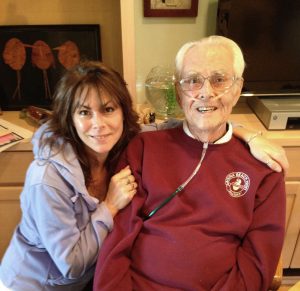Spiritual Well-being and Quality of Life for Patients Undergoing Chemotherapy
Pancreatic Cancer Blog – Commentary on Articles and AbstractsHere is where we take complex medical articles and break them down into language you and I
For over 22 years pancreatica.org has provided current, credible, and comprehensive information to those in need.
Cancer Patient’s Alliance is a 501(c)(3) non-profit organization. All donations are tax-deductible.
94% of all revenue goes towards our programs, with only 6% towards MANAGEMENT AND GENERAL EXPENSES.
Pancreatic cancer (ductal adenocarcinoma of the pancreas) in the early stages typically causes vague nonspecific symptoms. These symptoms and signs may include poor appetite, weight loss, abdominal or back pain, jaundice (yellowing of the eyes or skin, dark colored urine and/or light colored bowel movements) with or without itching, fatigue, nausea, and sometimes even depression. The general nature of these symptoms make the diagnosis of early pancreatic cancer is very difficult. Proceeding to a medical evaluation often requires a high index of suspicion by the patient or by medical personnel who are experienced with the presentation of pancreatic cancer.

The fear of pain is the leading concern of most patients with advanced pancreatic cancer. Often a vague mid-abdominal pain is one of the first symptoms of pancreatic cancer. There is no fixed pattern, but often, over time, the pain of pancreatic cancer may move or radiate more through the abdomen to the back area. Inadequately treated pain can have profound negative effects on the psychosocial and even physical well-being of pancreatic cancer patients, and may subject patients to unnecessary anxiety and even depression. On the positive side, there have never been more options for good pain relief, and in the vast majority of patients excellent pain control can be maintained by cooperative efforts with the help of an enlightened health-care team.
Since the publication of the World Health Organization’s suggested three-step analgesic “ladder” for pain control in 1986, pain is often classified as mild, moderate or severe. Mild pain is generally treated with a non-opioid analgesic agent (one which is not an opium-derived or opium-like narcotic) such as a non-steroidal anti-inflammatory drug like ibuprofen (Motrin). Moderate pain is treated with a “weak” opioid such as codeine with or without a non-opioid analgesic and with or without another adjuvant agent (such as an anti-anxiety drug). And severe pain is treated with a strong opioid such as morphine with or without a non-opioid analgesic and with or without another adjuvant agent (such as an anti-anxiety drug).
Examples of strong opioids include fentanyl, hydromorphone (Dilaudid), oxymorphone, meperidine (Demerol), methadone, and morphine. In addition to selecting the optimal agent(s), there are routes of administration to be considered. 70-90% of pain can be controlled by oral opioids. Other routes, for example, include those of injection (intravenous, subcutaneous or intramuscular), skin patches, rectal suppositories and pump-delivered (continuous or on-demand). The aim is to find an optimal agent(s) to be given at the optimal dose and via the optimal route of administration. The current concept among pain specialists is that the cancer patient should have around-the-clock pain relief. In addition, provisions are made to administer a fast-acting agent should the occasion occur of any “break-through” pain.
A specific palliative step in pancreatic cancer may include a nerve block of the celiac nerve plexus (located in the back/abdomen area where many patients feel pain with pancreatic cancer) via injection with alcohol or other agent. There are other possible interventions including subarachnoid or epidural blocks (both in the spinal space); and even further interventional and surgical measures which are available.
Alternative or non-invasive methods on the part of patients themselves exist, which may invoke mind-body control, including those of acupuncture, massage, biofeedback, relaxation, visualization techniques, hypnotherapy and others.
A thoughtful, integrated approach toward pain will result in very good pain control for almost all patients with pancreatic cancer.
As the pancreas is an integral part of the digestive system, it would stand to reason that gastrointestinal symptoms would figure prominently in pancreatic cancer.
Nausea and vomiting may be a problem in up to 40% of pancreatic cancer patients. The cause of these symptoms are varied-and can range from, for example, a reaction to chemotherapy or radiotherapy – to being a sign of mechanical obstruction of the small bowel. Consequently, the reason for the nausea and vomiting (sometimes referred to as “emesis”) needs to be sought out–and the underlying cause dealt with appropriately. In addition, anti-emetic agents may be prescribed. High-activity anti-emetic agents work as an antagonists to type-3 serotonin receptors and include such drugs as granisetron (Kytril) and ondansetron (Zofran). The anti-emetic activity of metoclopramide (Reglan) is now thought to be as both a serotonin and dopamine antagonist. Corticosteroids (such as dexamethasone) are also potent anti-emetics and may be used selectively in combination with serotonin antagonists to good effect. Older agents with generally lower anti-emetic activity, including the phenothiazines (such as phenergan or compazine), butyrophenones (such as Haldol) and the cannabinoids (such as Marinol) and others may have their place in selected circumstances. The action of each of these agents is somewhat different, and they each have side-effects which must be considered.
Constipation is a frequent complication of opioid therapy, and its prevention should begin at the onset of opioid therapy. Other causes of constipation in pancreatic cancer patients may include such elements as a low fiber diet, diminished fluid intake, diminished physical activity and postural effects from bed rest. More serious causes may include various metabolic abnormalities and even bowel obstruction. The treatment is various, but should include evaluating and correcting any underlying problems, insuring adequate fluid intake, increasing physical activity if possible, giving laxative drug therapy where appropriate and providing enemas as needed. Laxatives include such agents, for example, as lactulose, Senokot, colace and dulcolax.
Indigestion, diarrhea and a change in bowel habits are not uncommon in pancreatic cancer. The causes can range from the more mundane to the serious – and may, for example, include laxative overuse, malabsorption, anxiety or stress, infection, medication side-effect, radiation therapy, the effect of the cancer itself, surgery, pancreatic enzyme deficiency — and can even represent a sign of bowel obstruction. The treatment is individual, but should include evaluating and correcting any underlying problems. Food and fluid regulation are likely required. And anti-diarrheal medication may be indicated.
Weight loss and muscle wasting (cachexia) are common and occur in over 90% of patients with pancreatic cancer. These phenomena, apart from physiological disadvantage which contribute to fatigue and weakness, often have a pronounced deleterious effect on such factors as a patient’s sense of well-being. Contributors include anorexia, nausea, other gastrointestinal symptoms, depression, the side-effects of chemotherapy, surgery, new dietary constraints, early satiety (sense of stomach fullness), medical procedures and perhaps most importantly the metabolic effects of the pancreatic cancer itself. Some patients are unable to tolerate a diet which is high in fat and protein, and in others the onset of diabetes may occur.
These factors may have significant consequences on patients and their caregivers as, in the midst of these matters, a diet which is both palatable and effective is implemented. The help of a nutritionist is useful, almost mandatory. Adequate calories are required, including an adequate balance of protein, fat and carbohydrates. Some nutritionists recommend sources of omega-3 fatty acids. Vitamins and minerals may need augmentation. Pancreatic enzymes may be prescribed. Adequate fluid intake is important. The diabetes, if present, will need to be controlled. High-calorie liquid dietary supplements are often required. Intelligent experimentation with such measures as more frequent, smaller food portions can be helpful. The U.S. National Cancer Institute has provided access to an online guide entitled Eating Hints for Cancer Patients.
The use of appetite stimulants such as megestrol (Megace) and (according to some experts) corticosteroids (such as dexamethasone), as well as cannabinoids may be helpful in select patients.
Because the pancreatic tumor mass of ductal adenocarcinoma most commonly arises from the head of the pancreas (and in areas adjacent to the head of the pancreas) which are the sections where the bile duct joins with the pancreatic duct, the normal flow of the bile duct is often obstructed, thus disrupting the natural deposition of the bile fluid (including its bile salts and pigments) into the small bowel. This bile duct obstruction causes a back-up of the bile pigment into areas where it shouldn’t normally go – creating the clinical symptoms of jaundice with its attendant yellowish skin coloration and other associated changes, and which is often accompanied by a loss of appetite (anorexia) and by the symptom of unrelenting and often debilitating pruritis (itching) of the skin.
Additionally, the lack of bile salts which are now unavailable for normal digestive and other bowel processes, can result in complex physiological interactions leading to liver and immune dysfunction. This interruption of normal bile deposition may also disrupt the absorption of fat-soluble vitamins and the conjugation of endotoxins, thus leading to possible blood coagulation difficulties, malabsorption syndromes and even kidney failure. Also, up to ten percent of affected patients may develop cholangitis (an inflammatory condition of the biliary tree with often very serious consequences).
The treatment for this bile duct obstruction is some form of biliary bypass procedure. The majority of patients who receive such a procedure will experience relief of anorexia and jaundice, and will tend to live longer – in a more comfortable fashion. This bypass procedure is done via surgery and/or with the application of stents (inner wall prosthetic supports). The biliary stent prosthesis, in selected circumstances, may be placed via endoscopic route, without the necessity of resorting to full surgery. There are controversies in this area of treatment which are not yet resolved, none of these treatment options is without complication and it all is highly dependent on the individual situation. But progress has been made and options continue to improve, to the benefit of affected pancreatic cancer patients.
In some pancreatic cancer patients, there can be a troubling large collection of fluid in the abdominal cavity itself, which increases abdominal girth. This is called ascites (pronounced: as-site-ees), sometimes referred to as malignant ascites. The true cause of this fluid build-up is not fully understood, and may vary from person to person – but it is presumably often due in part to factors related to the existence of lymphatic or peritoneal metastases.
Some physicians will prescribe diuretic medication which may work well in select patients, but which also can give mixed results. Additionally, another approach is to offer patients with ascites an abdominal tap (or paracentesis), in which a special needle is inserted directly into the abdominal cavity and the fluid is drawn off. There are some risks to this procedure including the possible introduction of infection into the abdomen, but generally this procedure is surprising well-tolerated. Unfortunately – often – with progression over time, this abdominal tap procedure may need to be increasingly repeated. There do exist a number of very clever surgical shunting procedures which in select circumstances are employed, whereby through changes made to anatomic “plumbing,” the ascites fluid is internally re-routed back into the body’s own vascular system.
Fatigue can be an early symptom of pancreatic cancer, manifesting even before the diagnosis is made. Sooner or later, the majority of pancreatic cancer patients indicate fatigue as a significant symptom. Typically described as a loss of customary energy levels and even as effecting mental processes, the fatigue of pancreatic cancer can be debilitating.
The range of causes of fatigue under these circumstances is very large and can include such factors as the pancreatic cancer itself, sleeplessness (possibly due to pain or for other reasons), anemia, chemotherapy side-effect, anxiety or depression, medication side-effect (including pain medication), infection, electrolyte disturbance, or dehydration.
The treatment of fatigue is first directed at trying to eliminate any correctable medical or psychological underlying cause. This may include the adjustment of medications. Attention might be given to those factors which help promote adequate and restorative sleep. Short-term pharmaceutical aids to sleep may be prescribed. Hypnotic drugs such as Ambien (zolpidem tartrate) and Sonata (zaleplon) are sometimes used for these purposes.
Underlying psychological matters should be addressed. If possible, where appropriate, patients are encouraged to remain physically active, but not to overstep reasonable activity bounds. Some physicians will prescribe psychostimulant drugs in selected instances. But generally, the primary approach remains to take the symptom of fatigue seriously and to try to identify and remove specific underlying causes.
The following are descriptions of titles of abstracts of medical journal articles that may be interesting or useful to those who are interested in further information about this topic.These abstracts can be searched Here.
Most of our fundraisers, supporters, and volunteers, have been in one way or another, personally effected by this disease. We want to acknowledge what hardships you may have gone through (or are currently facing) and sincerely thank you for visiting our site!
Join us in our effort to fight pancreatic cancer. Donations go directly to promoting awareness, increasing education, furthering pancreatic cancer research aimed at early diagnosis and, helping patients and families impacted by the effects of pancreatic cancer. All Donations are tax-deductible.

Making IMPACT for Pancreatic Cancer Together!

MONTHLY MEMORIAL GIFTS:
Support Pancreatic Cancer Research!
Regular giving can be an opportunity to pay tribute in honour of a loved one. Your monthly gift will go directly to promoting awareness, increasing education, furthering pancreatic cancer research aimed at early diagnosis and, helping patients and families impacted by the effects of pancreatic cancer.
Simply select “Monthly” after choosing the amount you would like to give.
Cancer Patients Alliance is a 501(c)(3) non-profit. Initiatives include, ToFightCancer.com and Pancreatica.org. All Donations are tax-deductible.
Pancreatic cancer is expected to become the 2nd leading cause of cancer-related death by the year 2020. There are many reasons why the outcome for pancreatic cancer patients is much bleaker than for most other cancer types. There are no reliable methods to detect the disease early, and there are very few effective treatment options.
| There remains a dire need for more research and an increase in focused funding for pancreatic cancer. Your Donation will go directly to promoting awareness, increasing education, and furthering pancreatic cancer research aimed at early diagnosis. |
This year an estimated 57,600 Americans will be diagnosed with pancreatic cancer. Approximately 47,050 Americans are expected to die from the disease. There are many reasons why the outcome for pancreatic cancer patients is bleaker than for most other cancer types. There are no reliable methods to detect the disease early, and there are very few effective treatment options. Which is why we are so focused on supporting research for early diagnosis.
Together with You our Mission is to promote awareness, increase education, and further pancreatic cancer research aimed at early diagnosis.


CREATE YOUR OWN FUNDRAISER FOR PANCREATIC CANCER !
Create your own fun, choose something you already love to support pancreatic cancer! Simply set up your participation page, include the details of your fundraiser on your page, and get the word out!
Shop to Support Pancreatic Cancer !
Amazon donates 0.5% of the price of your eligible AmazonSmile purchases to help fight pancreatic cancer!
AmazonSmile is the same Amazon you know. Same products, same prices, same service. Simply use our Link to start shopping!
Best of the Pancreatic Cancer Blog
Pancreatic Cancer Blog – Commentary on Articles and AbstractsHere is where we take complex medical articles and break them down into language you and I
Pancreatic Cancer Blog – Commentary on Articles and AbstractsHere is where we take complex medical articles and break them down into language you and I
Pancreatic Cancer Blog – Commentary on Articles and AbstractsHere is where we take complex medical articles and break them down into language you and I
This study is basically looking at whether aspirin can make a chemotherapy drug called gemcitabine work better for pancreatic cancer. You’ve probably heard of aspirin; it’s the stuff you take for a headache or fever.
© 2024 Pancreatica. All rights reserved | Privacy Policy
312 Fountain Avenue, Pacific Grove, California 93950 | Phone: (831) 658-0600 | Fax: (831) 658-0518 | participate@tofightcancer.com